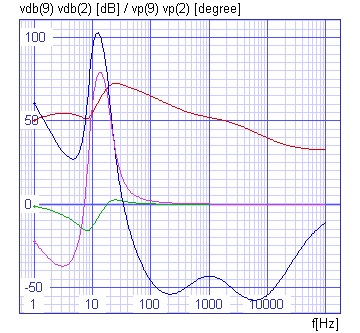
updated 2000.12.01
Author Janez Puhan
Phono Preamplifier
The circuit
Today's phono records are played back with magnetic pickups which allow high fidelity sound reproduction. They deliver an audio frequency voltage proportional to the velocity of the pickup stylus. During recording, the velocity cannot be held constant over an extended range of frequency. Below 500Hz it will be reduced and above 2120Hz it will be emphasised. In order for the voltage at the speaker to be a true image of the voltage at the microphone, the frequency response of the phono preamplifier has to be an inverted mirror image of that of the recording equipment.
Due to convention, the constant velocity of the stylus is applied only in the frequency range of 500-2120Hz. At lower frequencies, deviation of the stylus as the ratio of velocity and angular frequency would exceed reasonable limits when compared to the groove spacing and playing time. From 50 to 500Hz, the response of the velocity has a slope of 6dB/octave. Below 50Hz, rumble of the turntable may cause interference, therefore, the velocity is held constant. Similar considerations hold true for frequencies above 2120Hz. Here, a record noise is more prevalent and it is appropriate to emphasise these frequencies with 6dB/octave.

The input file
phono preamplifier
.control
ac dec 40 1Hz 100kHz
set units = degrees
plot vdb(9) vdb(2) vp(9) vp(2) xlabel f[Hz]
+ ylabel 'vdb(9) vdb(2) [dB] / vp(9) vp(2) [degree]' title 'AC analysis'
.endc
v1 1 0 dc 0 ac 1
r1 1 2 390k
r2 3 4 27k
r3 5 4 15
r4 4 0 150
r5 8 9 6.8k
r6 6 7 560k
r7 7 8 47k
c1 1 3 0.18uF
c2 3 2 0.18uF
c3 5 6 100uF
c4 6 7 5.6nF
c5 7 8 1.5nF
e1_amp 9 0 2 6 1meg
.end
The results
